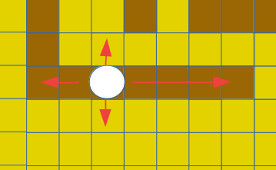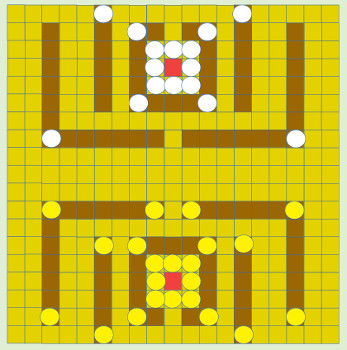Castle (or "Czech Castle")
Written by Howard Fosdick © BestFreeNewGames.com
Overview: Castle is a virtually unknown but entertaining strategic board game. The rules are trivial to learn yet it's challenging and fun.
Objective: You win the game either by moving one of your pieces into the enemy castle, or by eliminating all enemy pieces from the board.
Set Up:
The board measures 19 by 19 squares. To start, place 8 playing pieces for each player as shown in the diagram.
Each player's castle is indicated by the red square nearest their men. The dark brown squares are walls. The light brown or tan squares are the ground.
Randomly decide who will take the first turn (alternate in subsequent games).

Play: Players alternate turns. In his turn, each player moves one man. He is required to do so.
Movement:
Pieces move either horizontally or vertically any number of vacant squares in one direction in one turn. This is just like a Rook in Chess. Pieces move like Rooks regardless of whether they are moving across wall squares or ground squares.
Pieces can not move through men on their own side. And they can never move diagonally.
There is one exception to this rule of movement -- transitioning between a wall and a ground square. To climb onto a wall square from a ground square, a man must be immediately adjacent to the wall square. Then he takes one turn to move the one square up onto the wall.
Similarly, a piece requires a turn to jump off a wall, and only moves a single square when doing so.
The second diagram shows how the men move. They move any number of open squares in a single direction, vertically or horizontally. But they move only a single square when climbing onto or jumping off of a wall.
Capturing:
Pieces capture enemy men just like in Chess. Your piece moves onto and occupies the square on which the enemy piece resides, and you remove the enemy piece from the board. Whether to capture a vulnerable enemy piece is at a player's discretion (capturing is not mandatory).

Victory:
As soon as one player moves one of his markers onto his enemy's castle square, he wins and the game ends. The game also ends if one side eliminates all the other player's markers.
-----------------------------------
Variants:
You might also try the game with either 16 pieces per side, or 22 per player. The upper half of the third diagram shows how to set up for the 16-piece variant with the white checkers, while the lower half of the illustration shows how to initialize play for the 22-piece variant with the yellow markers.

-----------------------------------
Tips for Play:
I recommend you first play the game with only 8 markers per side. After you gain experience, try the versions with 16 or 22 pieces to see if you like them better. Personally I prefer the uncluttered board where each piece counts more in your strategic endeavour.
Though at first glance Caslte seems like a typical game of "capture the enemy markers", in many ways it's more a game of movement. Men sweep across the board like chess rooks... but the walls stop them cold. Clever use of the walls becomes what defence is all about, while they hamper your own offence in storming the enemy castle.
Note especially the configuration of the walls. A side attack towards the enemy castle requires potentially breaching three walls. A centre attack confronts only two walls... and the outermost has a hole in the middle! You'll want both your attacking and defensive strategies to take the wall designs into full account.
Corner positions that cover dual wide-ranging vertical and horizontal pathways are defensively advantageous. For example, the initial position of the two outermost markers for each player protects the two outermost walls for a cost of only two markers. The two corner positions immediately inside those -- on the ground -- could also be important defensively.
In general, it's pretty difficult to crack a well-structured defense that optimally uses the interior walls. Sometimes marker trade-offs make this easier.
The ground squares in the centre and along the edges of the board facilitate movement. Your man can traverse the entire board in one turn. This can be used to quickly alter the "weight" of the board from one locale to another. It could also form the basis for an attack that quickly shifts from one defensive position to another.
As in checkers and many similar games, if you can get some early 2-for-1 or 3-for-2 trade-offs, this advantage can position you for later victory. But keep in mind that in this game, unlike Checkers and its variants, capture is not mandatory. Rather, it is optional, as in Chess. That makes a big difference in setting up any trade-offs.
There are 19 x 19 or 361 total board positions. 106 are wall squares while the remaining 255 are ground-level. This ratio of ground to wall squares again emphasises the role of the ground for wide-ranging movement.
The game variants featuring either 16 or 22 pieces reduce the importance of movement, at least in the early game. The board is much more cluttered and so movement is initially somewhat restricted. Strategies to capture enemy pieces become more important. Remember, your own pieces potentially block the movement of your other markers.
The variants with more pieces become much more like the parent game if the game matures to the point where the players have reduced enemy forces to smaller numbers.
-----------------------------------
Print Your Own Game Board:
Want to print your own game board? Just
click here. You don't need to search for a board for this rare game, or buy anything to play.
-----------------------------------
Play Castle on Your Go Board:
If you have a full-sized 19 by 19 game board for Go, you can use that for playing Castle. In this case, play on the lines instead of inside the squares. This final illustration shows how.

Click here for more free games on this website.
-----------------------------------
Sources:
The game appears in The Great Encyclopedia of Games by Czech author Miloš Zapletal published in Prague in 1986. One online source for the game is
The Bona Ludo website.
-----------------------------------
License: Feel free to print, copy, and distribute these rules, so long as you retain this paragraph. Written by Howard Fosdick © 2023, distributed under Creative Commons License BY-ND. HOME